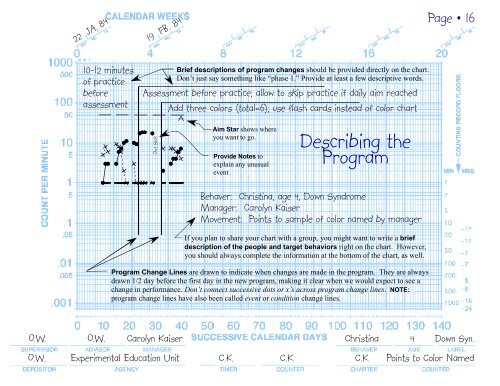The Chart Book
The Chart Book
The Chart Book
Create successful ePaper yourself
Turn your PDF publications into a flip-book with our unique Google optimized e-Paper software.
A<br />
10-12 minutes<br />
of practice<br />
before<br />
assessment<br />
O.W. O.W. Carolyn Kaiser<br />
Brief descriptions of program changes should be provided directly on the chart.<br />
Don’t just say something like “phase 1.” Provide at least a few descriptive words.<br />
Assessment before practice; allow to skip practice if daily aim reached<br />
Add three colors (total=6); use flash cards instead of color chart<br />
Aim Star shows where<br />
you want to go.<br />
Provide Notes to<br />
explain any unusual<br />
event<br />
Describing the<br />
Program<br />
Behaver: Christina, age 4, Down Syndrome<br />
Manager: Carolyn Kaiser<br />
Movement: Points to sample of color named by manager<br />
If you plan to share your chart with a group, you might want to write a brief<br />
description of the people and target behaviors right on the chart. Howevcr,<br />
you should always complete the information at the bottom of the chart, as well.<br />
Program Change Lines are drawn to indicate when changes are made in the program. <strong>The</strong>y are always<br />
drawn 1/2 day before the first day in the new program, making it clear when we would expect to see a<br />
change in performance. Don’t connect successive dots or x’s across program change lines. NOTE:<br />
program change lines have also been called event or condition change lines.<br />
Page • 16<br />
Christina 4 Down Syn.<br />
O.W. Experimental Education Unit C.K. C.K. C.K. Points to Color Named


